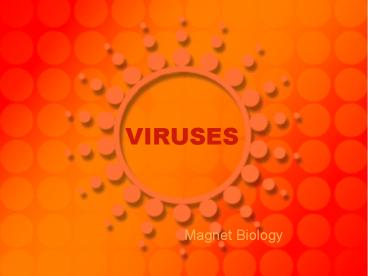VIRUSES - PowerPoint PPT Presentation
Title: VIRUSES
1
VIRUSES
- Magnet Biology
2
Characteristics of Viruses
- Tiny, non-living strand of genetic material
within a protein coat - Do not respire, move grow
- Cannot reproduce on their own
- Must reproduce inside of a host cell
- Typical infection lasts 7-10 days
- Not given Latin names named for disease caused,
organ infected, or region detected in
3
Structure of Viruses
- All viruses consist of 2 basic parts
- nucleic acid (genetic material)
- protein coat (capsid)
- Capsid protein coat containing inner core of DNA
or RNA - May have tail fibers and projections to aid in
attachment - Some have extra outer layer called envelope
Animation http//www.johnkyrk.com/virus.html
4
Structure of Viruses
- Several types of viral arrangements classified by
the type of nucleic acid - Adenovirus (common cold)
- Influenza virus (flu)
- Bacteriophage (infects bacteria)
- Tobacco mosaic virus
5
(No Transcript)
6
Viral recognition and attachment
- Virus must recognize specific receptor site on
host cell - Lands on host and locks in
- Attachment is specific virus can enter and
reproduce in only a few types of cells - Ex tobacco mosaic virus cannot affect human
cells even though we are exposed to it daily
7
Viral reproduction
- Viruses must reproduce inside of a host cell
- They are classified as intracellular parasites
- The method of entry into the host cell depends on
the virus - There are two main types of viral reproduction
- 1. Lytic cycle
- 2. Lysogenic cycle
8
Lytic Cycle
- Lytic cycle viral DNA takes over host nucleus,
produces new viruses, the cell fills with new
viruses, at the end the cell bursts and the cell
dies
9
Steps of the Lytic Cycle
- ATTACHMENT virus attaches to the cell surface
2. ENTRYinjects DNA, takes over host nucleus
10
3. REPLICATIONreproduces virus parts 4.
ASSEMBLYputs virus parts together into mature
viruses
5. RELEASE/LYSEScell splits open releasing
viruses that can infect others
11
Lytic Cycle
- Active infections immediate symptoms appear 1-4
days after exposure to the virus (common cold and
flu) - http//www.rattlerscience.com/life/classes/apbiolo
gy/documents/Unit2010/18_Lectures_PPT/media/18_06
PhageT4LyticCycle_A.swf
12
Lysogenic Cycle
- Viral genetic material enters into the chromosome
of a host cell - Viral genetic material is mixed with host DNA
13
Lysogenic Cycle
- Does not immediately begin to reproduce, host may
function normally while virus stays dormant - Provirus can pop out at any time and begin
reproducing - Example Herpes (cold sores, fever blisters) The
infected cell will have the viral genes
permanently - Reactivation results in the lytic cycle
- http//www.rattlerscience.com/life/classes/apbiolo
gy/documents/Unit2010/18_Lectures_PPT/media/18_07
LysogenicLyticCycles_A.swf
14
(No Transcript)































